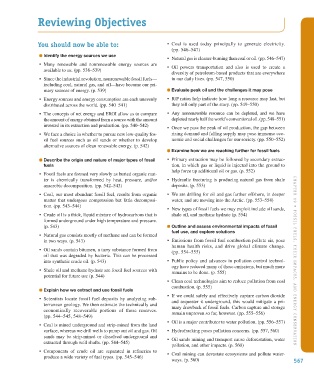Page 568 - Environment: The Science Behind the Stories
P. 568
Reviewing Objectives
You should now be able to: • Coal is used today principally to generate electricity.
(pp. 546–547)
Identify the energy sources we use
• Natural gas is cleaner-burning than coal or oil. (pp. 546–547)
• Many renewable and nonrenewable energy sources are • Oil powers transportation and also is used to create a
available to us. (pp. 538–539)
diversity of petroleum-based products that are everywhere
• Since the industrial revolution, nonrenewable fossil fuels— in our daily lives. (pp. 547, 550)
including coal, natural gas, and oil—have become our pri-
mary sources of energy. (p. 539) Evaluate peak oil and the challenges it may pose
• Energy sources and energy consumption are each unevenly • R/P ratios help indicate how long a resource may last, but
distributed across the world. (pp. 540–541) they tell only part of the story. (pp. 549–550)
• The concepts of net energy and EROI allow us to compare • Any nonrenewable resource can be depleted, and we have
the amount of energy obtained from a source with the amount depleted nearly half the world’s conventional oil. (pp. 548–551)
invested in its extraction and production. (pp. 540–542)
• Once we pass the peak of oil production, the gap between
• We face a choice in whether to pursue new low-quality fos- rising demand and falling supply may pose immense eco-
sil fuel sources such as oil sands or whether to develop nomic and social challenges for our society. (pp. 550–552)
alternative sources of clean renewable energy. (p. 542)
Examine how we are reaching further for fossil fuels
Describe the origin and nature of major types of fossil • Primary extraction may be followed by secondary extrac-
fuels tion, in which gas or liquid is injected into the ground to
help force up additional oil or gas. (p. 552)
• Fossil fuels are formed very slowly as buried organic mat-
ter is chemically transformed by heat, pressure, and/or • Hydraulic fracturing is producing natural gas from shale
anaerobic decomposition. (pp. 542–543) deposits. (p. 553)
• Coal, our most abundant fossil fuel, results from organic • We are drilling for oil and gas further offshore, in deeper
matter that undergoes compression but little decomposi- water, and are moving into the Arctic. (pp. 553–554)
tion. (pp. 543–544)
• New types of fossil fuels we may exploit include oil sands,
• Crude oil is a thick, liquid mixture of hydrocarbons that is shale oil, and methane hydrate (p. 554)
formed underground under high temperature and pressure.
(p. 543) Outline and assess environmental impacts of fossil
fuel use, and explore solutions
• Natural gas consists mostly of methane and can be formed
in two ways. (p. 543) • Emissions from fossil fuel combustion pollute air, pose
human health risks, and drive global climate change.
• Oil sands contain bitumen, a tarry substance formed from (pp. 554–555)
oil that was degraded by bacteria. This can be processed
into synthetic crude oil. (p. 543) • Public policy and advances in pollution control technol- CHAPTER 19 • FOSSIL FUELS, THEIR IMPA CT S, AND ENERGY CONSERVATI ON
ogy have reduced many of these emissions, but much more
• Shale oil and methane hydrate are fossil fuel sources with remains to be done. (p. 555)
potential for future use (p. 544)
• Clean coal technologies aim to reduce pollution from coal
combustion. (p. 555)
Explain how we extract and use fossil fuels
• If we could safely and effectively capture carbon dioxide
• Scientists locate fossil fuel deposits by analyzing sub- and sequester it underground, this would mitigate a pri-
terranean geology. We then estimate the technically and mary drawback of fossil fuels. Carbon capture and storage
economically recoverable portions of those reserves. remain unproven so far, however. (pp. 555–556)
(pp. 544–545, 548–549)
• Oil is a major contributor to water pollution. (pp. 556–557)
• Coal is mined underground and strip-mined from the land
surface, whereas we drill wells to pump out oil and gas. Oil • Hydrofracking poses pollution concerns. (pp. 557, 560)
sands may be strip-mined or dissolved underground and • Oil sands mining and transport cause deforestation, water
extracted through well shafts. (pp. 544–545)
pollution, and other impacts. (p. 560)
• Components of crude oil are separated in refineries to • Coal mining can devastate ecosystems and pollute water-
produce a wide variety of fuel types. (pp. 545–546)
ways. (p. 560) 567
M19_WITH7428_05_SE_C19.indd 567 12/12/14 5:23 PM

